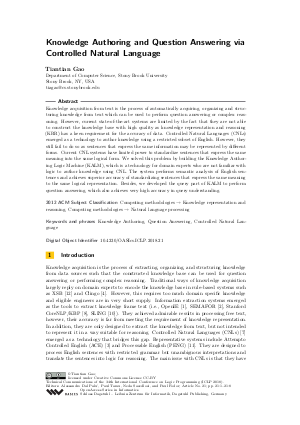Knowledge Authoring and Question Answering via Controlled Natural Language
Author Tiantian Gao
-
Part of:
Volume:
Technical Communications of the 34th International Conference on Logic Programming (ICLP 2018)
Part of: Series: Open Access Series in Informatics (OASIcs)
Part of: Conference: International Conference on Logic Programming (ICLP) - License:
 Creative Commons Attribution 3.0 Unported license
Creative Commons Attribution 3.0 Unported license
- Publication Date: 2018-11-19
File

PDF
OASIcs.ICLP.2018.21.pdf
- Filesize: 383 kB
- 8 pages
Document Identifiers
Subject Classification
ACM Subject Classification
- Computing methodologies → Knowledge representation and reasoning
- Computing methodologies → Natural language processing
Keywords
- Knowledge Authoring
- Question Answering
- Controlled Natural Language
Metrics
- Access Statistics
-
Total Accesses (updated on a weekly basis)
0Document
0Metadata
Abstract
Knowledge acquisition from text is the process of automatically acquiring, organizing and structuring knowledge from text which can be used to perform question answering or complex reasoning. However, current state-of-the-art systems are limited by the fact that they are not able to construct the knowledge base with high quality as knowledge representation and reasoning (KRR) has a keen requirement for the accuracy of data. Controlled Natural Languages (CNLs) emerged as a technology to author knowledge using a restricted subset of English. However, they still fail to do so as sentences that express the same information may be represented by different forms. Current CNL systems have limited power to standardize sentences that express the same meaning into the same logical form. We solved this problem by building the Knowledge Authoring Logic Machine (KALM), which is a technology for domain experts who are not familiar with logic to author knowledge using CNL. The system performs semantic analysis of English sentences and achieves superior accuracy of standardizing sentences that express the same meaning to the same logical representation. Besides, we developed the query part of KALM to perform question answering, which also achieves very high accuracy in query understanding.
Cite As Get BibTex
Tiantian Gao. Knowledge Authoring and Question Answering via Controlled Natural Language. In Technical Communications of the 34th International Conference on Logic Programming (ICLP 2018). Open Access Series in Informatics (OASIcs), Volume 64, pp. 21:1-21:8, Schloss Dagstuhl – Leibniz-Zentrum für Informatik (2018)
https://doi.org/10.4230/OASIcs.ICLP.2018.21
BibTex
@InProceedings{gao:OASIcs.ICLP.2018.21,
author = {Gao, Tiantian},
title = {{Knowledge Authoring and Question Answering via Controlled Natural Language}},
booktitle = {Technical Communications of the 34th International Conference on Logic Programming (ICLP 2018)},
pages = {21:1--21:8},
series = {Open Access Series in Informatics (OASIcs)},
ISBN = {978-3-95977-090-3},
ISSN = {2190-6807},
year = {2018},
volume = {64},
editor = {Dal Palu', Alessandro and Tarau, Paul and Saeedloei, Neda and Fodor, Paul},
publisher = {Schloss Dagstuhl -- Leibniz-Zentrum f{\"u}r Informatik},
address = {Dagstuhl, Germany},
URL = {https://drops.dagstuhl.de/entities/document/10.4230/OASIcs.ICLP.2018.21},
URN = {urn:nbn:de:0030-drops-98870},
doi = {10.4230/OASIcs.ICLP.2018.21},
annote = {Keywords: Knowledge Authoring, Question Answering, Controlled Natural Language}
}
Author Details
References
-
Gabor Angeli, Melvin Jose Johnson Premkumar, and Christopher D. Manning. Leveraging Linguistic Structure For Open Domain Information Extraction. In 53rd Annual Meeting of the Association for Computational Linguistics, pages 344-354, Beijing, China, 2015.

- Dipanjan Das, Desai Chen, André F. T. Martins, Nathan Schneider, and Noah A. Smith. Frame-Semantic Parsing. Comp, Linguistics, 40(1):9-56, 2014. URL: http://dx.doi.org/10.1162/COLI_a_00163.
-
Norbert E. Fuchs, Kaarel Kaljurand, and Tobias Kuhn. Attempto Controlled English for Knowledge Representation. In Reasoning Web, 4th Intl. Summer School, Sept. 7-11, pages 104-124, Venice, Italy, 2008.

-
Martin Gebser, Benjamin Kaufmann, Roland Kaminski, Max Ostrowski, Torsten Schaub, and Marius Thomas Schneider. Potassco: The Potsdam Answer Set Solving Collection. AI Commun., 24(2):107-124, 2011.

-
Chrstopher R. Johnson, Charles J. Fillmore, Miriam R.L. Petruck, Collin F. Baker, Michael J. Ellsworth, Josef Ruppenhofer, and Esther J. Wood. FrameNet: Theory and Practice, 2002.

-
Hans Kamp and Uwe Reyle. From discourse to logic: Introduction to modeltheoretic semantics of natural language, formal logic and discourse representation theory, volume 42. Springer Science &Business Media, 2013.

-
Tobias Kuhn. A Survey and Classification of Controlled Natural Languages. Comp. Linguistics, 40(1):121-170, 2014.

- Christopher D. Manning, Mihai Surdeanu, John Bauer, Jenny Finkel, Steven J. Bethard, and David McClosky. The Stanford CoreNLP Natural Language Processing Toolkit. In Association for Computational Linguistics (ACL) System Demonstrations, pages 55-60, 2014. URL: http://www.aclweb.org/anthology/P/P14/P14-5010.
-
Roberto Navigli and Simone Paolo Ponzetto. BabelNet: The automatic construction, evaluation and application of a wide-coverage multilingual semantic network. Artificial Intelligence, 193:217-250, 2012.

- Michael Ringgaard, Rahul Gupta, and Fernando C. N. Pereira. SLING: A framework for frame semantic parsing. CoRR, 1710.07032:1-9, 2017. URL: http://arxiv.org/abs/1710.07032.
-
Rolf Schwitter. English as a Formal Specification Language. In 13th Intl. Workshop on Database and Expert Systems Appl. (DEXA 2002), pages 228-232, Aix-en-Provence, France, 2002.

-
T. Swift and D.S. Warren. XSB: Extending the power of prolog using tabling. Theory and Practice of Logic Programming, 2011.

